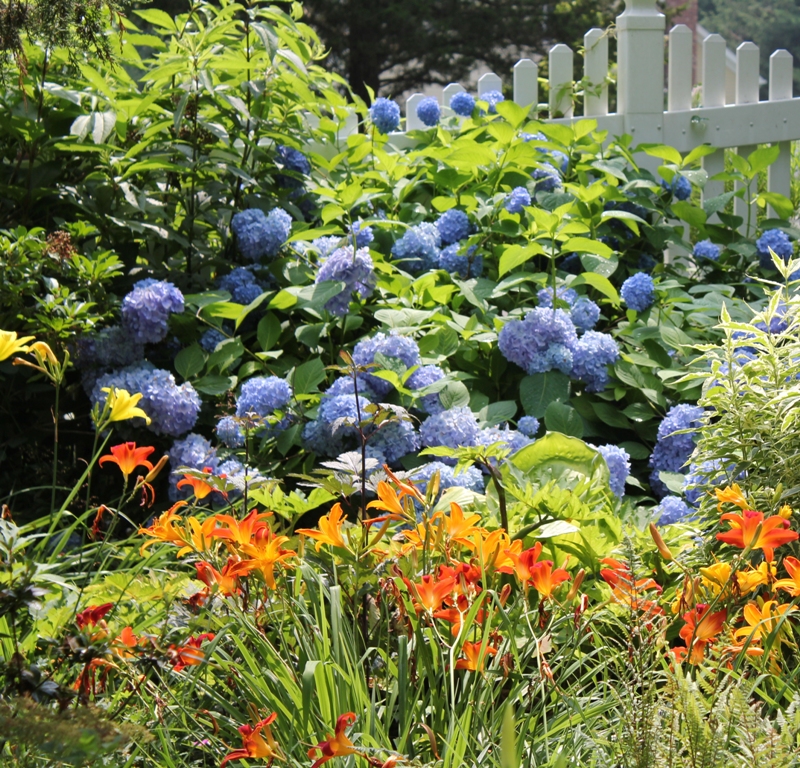Originally appeared at National Gardening Bureau
Are Your Hydrangeas Blooming?
Every gardener I talk to, especially in the northeast and New England, is doing a happy dance this season: their hydrangeas are in full bloom. Despite temperature fluctuations, the sudden freezing temperatures of November 2019, and the wacky late spring weather we had (hailstorms, sub-freezing temps), these magnificent shrubs came through. All those dogs you have that haven’t been flowering are finally showing their colors. Or are they?
If your big leaf and mountain hydrangeas aren’t blooming this year, it’s time to do a quick Hydrangea Check Up.
First a little science…
How Hydrangeas Set Their Flower Buds
Big leaf and mountain hydrangeas bloom at the tip of the stems they produced last year (old wood). Some also flower on the sides of those same stems (new wood). Still others flower on stems they produce in the current year (new wood). The old wood plants start making those buds about August 1 and then need to hold on to them for nearly nine months, through late fall, winter, and early spring. Which means anytime you cut stems after August 1 on your old wood plants, you risk losing the following year’s flowers.
No Pruning After August 1st

So rule #1: don’t prune them until you see the buds emerge, sometimes as late as June. The buds look like little heads of broccoli. Only then will you know which stems and buds met their seasonal challenges.
If your shrub isn’t flowering, the first thing you need to check is when you cut them, if at all. Most times these plants don’t need pruning except to remove damaged, diseased, or dead stems.
Check Your Plant’s Hardiness Rating for Your Garden
If pruning isn’t your downfall, then check your shrub’s hardiness rating. Is it the right one for your growing zone? Keep in mind that the hardiness factor for hydrangeas can be confusing. The 2012 USDA Plant Hardiness guideline map is the standard by which gardeners can determine which plants are most likely to survive. The map is based on the average annual minimum winter temperature, divided into 10-degree F zones. The rating addresses a plant’s ability to SURVIVE low temperatures, i.e., will the roots make it? With hydrangeas, you need to go one step further to consider how well the STEMS survive. That’s the tricky part.
One way to figure out which plants will reliably flower in your zone is to ask your local garden center and the experienced gardeners you know. We all have stories of plants that were supposed to do fine and just didn’t. Hydrangeas are no exception.
Consider Your Soil
Once you check the hardiness factor, look at your growing conditions. Is the soil composition right? Are you providing enough organic matter? This Coast of Maine blog about soil may highlight what you need to do. And what about mulch? Fortunately, there are lots of options for you when it comes to organic matter and mulch. You just have to decide which one you need and put it down.
Add the Right Amount of Sun
Many of us underestimate a hydrangea’s need for sun. About half a day is a suitable target, ideally in the morning. But if you only have a place with the afternoon sun, that’s OK. Except if you garden in southern states. Southern gardeners need to avoid that scorching afternoon sun. Regardless of where you site your plant, you always need to keep an eye out that they don’t cook.
Watch The Fertilizer
With fertilizer, more is not better. In fact, if you give your hydrangeas too much nitrogen (the first number on the package), you’ll get a beautiful green bush and few flowers. Organic or time-release shrub, rose, or flower food will provide the correct balance of the right nutrients that the plant can take up as needed.
The Importance Of Persistent Winter Protection
During this Hydrangea Check Up, take a hard look at where in your garden you have your plant. Hydrangeas don’t like icy winter storms and drying winds. Both conditions risk killing the precious flower buds. If the prevailing winter winds and storms expose your plants, figure out where to move them when transplant time comes later this season. Your ideal location would be some place that has persistent winter protection.
Think needled conifers, rhododendrons, azaleas, fences, sheds—you get the idea. Even shrubby deciduous plant hedges (like Spiraea) can work. Deciduous plants that hold their foliage through the winter like oaks, beeches, and parrotias can make effective sheltered planting pockets. All of those options block the wind, ice, and snow and will provide critical cover for your plant.
Reblooming Magic

Rebloomer Hydrangea will bloom on both old and new wood – National Garden Bureau
But what if you can’t move your plant and can’t provide winter protection? Then consider trading it out for a rebloomer. A plant that reblooms will usually include that information on the tag. These are the newer hydrangeas that flower on both old and new growth. When the buds at the tip get frozen off, the plant produces other flowers along the length of the stem. This year for me, no terminal buds survived from last year. BUT, all of my rebloomers have buds and flowers coming from the side shoots on the stems.
What To Do With Your Old Plants
If you’re like me, you can’t bear to toss a live plant on the compost heap. So what do you do with the hydrangea you just replaced? Donate it! Local garden clubs are always interested in donations for their annual plant sales and fundraisers. Don’t forget churches and community facilities which will usually be more than grateful for your donation.
Here’s to Hydrangea Happiness, a Reality Not Just a Myth!
Written By: Lorraine Ballato
Author of: Success With Hydrangeas: A Gardener’s Guide


